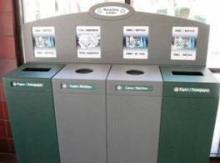Recycling and prescription drug overdoses have something in common.
Recycling has become second nature in many parts of America. Bins and containers to collect excess paper, bottles and cans are ubiquitous. Yet, only a few a few decades ago, recycling seemed foreign, was not convenient, and took some effort and resolve on an individual’s part.
That same evolution has to happen in the way that we handle leftover medications, Keith N. Humphreys, Ph.D., told physicians at the American Academy of Pain Medicine annual meeting. There’s an epidemic of opioid overdose deaths in the United States, and the most common source of misused opioids is leftover medications obtained from friends and family.
He’s talking about a huge cultural shift – with consumers going from saving and sharing costly medications that can be hard to come by in the current health system to recognizing their potential for harm and routinely returning leftover drugs on “take-back days” organized by law enforcement or even depositing them in specialized “recycling” bins.
The number of opioid prescriptions dispensed by U.S. retail pharmacies increased from 76 million in 1991 to 210 million in 2010, according to a report by the National Institute on Drug Abuse. And since 1990, the rate of drug overdoses has tripled, increasing approximately from 4 per 100,000 people to 12 per 100,000 people, the Centers for Disease Control and Prevention report.
As someone who worked in hospices for a decade, Dr. Humphries knows the valuable role that opioids can play in relieving pain. So, how do we make opioids available but reduce the risk of addiction, abuse and accidental overdose?
There is no policy framework that will eliminate the tension between these two goals, but some policies will help avoid it, said Dr. Humphreys, acting director of the Center for Health Care Evaluation, Veterans Health Administration, Menlo Park, Calif., and a professor of psychiatry at Stanford University. He recently served as senior policy adviser at the White House Office of National Drug Control Policy, and reports having no financial conflicts of interest on this issue.
Here, he said, are five emerging public policies, codes of practice, and cultural norms that “most people can agree on” while working toward harder-to-implement options like expanding addiction treatment programs:
1) Build prescription monitoring programs (PMPs). The idea is that physicians could check to see if a patient has received another opioid prescription recently before handing over a new prescription, to prevent drug-seeking patients from “doctor-shopping” to get more opioids. Thirty-six states have PMPs, though most are early versions that are slow, clunky and virtually worthless. Fourteen states and the District of Columbia have enacted legislation to create PMPs, and two states have no PMP plans.
PMPs “may be resisted and resented by many professionals, but they’re inevitable” and deserve support to quickly improve, Dr. Humphreys said. Plus, there’s a bonus for prescribers: In some states, checking with the PMP before prescribing an opioid gives physicians presumptive immunity from legal liability.
2) Lock doctor shoppers into one prescriber. Every week, a West Virginian dies of a drug overdose while holding prescriptions from five or more health care providers. Public and private insurers could tell patients who have opioid prescriptions from multiple providers that they must get all prescriptions from a single provider if they want their insurance to cover costs.
3) Make prescription “recycling” a cultural norm. Legally, opioid narcotics can be returned to any Drug Enforcement Agency law enforcer, though some states also allow pharmacies to take back leftover drugs. When sheriffs in one small Arkansas town (population 20,000) organized a drug take-back day, residents brought in 25,000 pills, Dr. Humphreys said. A physician at the meeting from Santa Maria, Calif., said a drug take-back day organized by sheriffs there was so successful that they installed a permanent drop-off box outside the sheriff’s office. Dr. Humphreys urged physicians to promote drug take-back days in their communities.
4) Make abuse-resistant medication approvals easier. Currently, developing an abuse-resistant version of an addictive medication requires a new drug application, engendering a lengthy approval process and potentially hundreds of millions of dollars in costs. Government regulators should find a way to ease this massive disincentive for pharmaceutical companies to develop safer pain medicines, he said.



